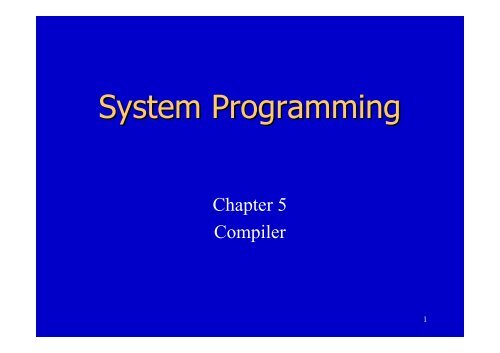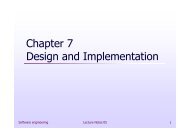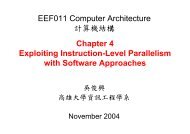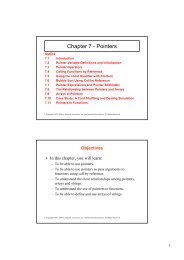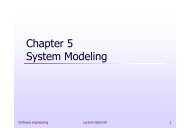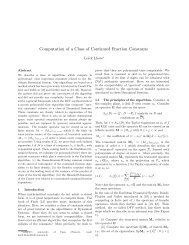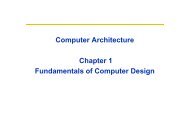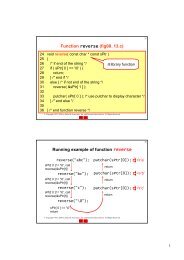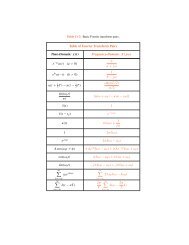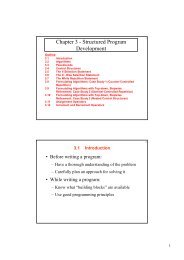System Programming
System Programming
System Programming
Create successful ePaper yourself
Turn your PDF publications into a flip-book with our unique Google optimized e-Paper software.
<strong>System</strong> <strong>Programming</strong><br />
Chapter 5<br />
Compiler<br />
1
Compiler<br />
2
Basic Compiler Functions<br />
Grammars<br />
Lexical Analysis<br />
Syntactic Analysis<br />
Code Generation<br />
3
Terminology<br />
• Statement ( 敘 述 )<br />
–Declaration, assignment containing expression ( 運 算 式 )<br />
• Grammar ( 文 法 )<br />
–A set of rules specify the form of legal statements<br />
• Syntax ( 語 法 ) vs. Semantics ( 語 意 )<br />
–Example: assuming I, J, K: integer and X,Y: float<br />
–I:=J+K vs. X:= I+Y<br />
• Compilation ( 編 譯 )<br />
–Matching statements (written by programmers) to structures<br />
(defined by the grammar) and generating the appropriate<br />
object code<br />
4
Basic Compiler<br />
•Lexical analysis - scanner<br />
–Scanning the source statement, recognizing and<br />
classifying the various tokens<br />
•Syntactic analysis - parser<br />
–Recognizing the statement as some language<br />
construct.<br />
–Construct a parser tree (syntax tree)<br />
•Code generation –code generator<br />
–Generate assembly language codes<br />
–Generate machine codes (Object codes)<br />
5
High-Level <strong>Programming</strong> Language<br />
• A high-level programming language is described in terms of a<br />
grammar, which specifies the syntax of legal statements.<br />
– An assignment statement:<br />
• a variable name + an assignment operator + an expression<br />
6
Grammars<br />
•A grammar for a language is a formal<br />
description of the syntax.<br />
–The grammar does not describe the semantics<br />
(meaning) of the various statement.<br />
•Example: I, J, K: integer and X,Y: float<br />
–I:=J+K vs. I:= X+Y<br />
–Identical syntax<br />
–Different semantics<br />
• integer arithmetic operation<br />
• Floating-point addition<br />
–Very different sequences of machine instructions<br />
• Recognized during code generation<br />
8
BNF (Backus-Naur Form)<br />
• A simple and widely used notations for writing grammars<br />
introduced by John Backus and Peter Naur in about 1960.<br />
• A BNF grammar consists of a set of rules, each of which defines<br />
the syntax of some construct in the programming language.<br />
• Meta-symbols of BNF:<br />
– ::= "is defined as"<br />
– | "or"<br />
– < > angle brackets used to surround non-terminal symbols<br />
• Entries not enclosed in angle brackets are terminal symbols of the grammar<br />
(i.e., token).<br />
• A BNF rule defining a nonterminal has the form:<br />
– nonterminal ::= sequence_of_alternatives consisting of strings of terminals<br />
(tokens) or nonterminals separated by the meta-symbol<br />
9
Simplified Pascal Grammar<br />
Recursive rule<br />
10
Parse Tree<br />
(Syntax Tree)<br />
READ(VALUE)<br />
VARIANCE:=SUMSQ DIV 100<br />
–MEAN*MEAN<br />
The multiplication and division<br />
precede the addition and<br />
subtraction<br />
12
Parse Tree<br />
•If there is more than one possible parse tree for a<br />
given statement, the grammar is said to be<br />
ambiguous.<br />
13
Parse Tree<br />
14
Parse Tree<br />
15
Scanner<br />
•Recognize keywords, operators, integers,<br />
floating-point numbers, character strings and<br />
identifiers.<br />
•The exact set of tokens to be recognized depends<br />
on the programming language be compiled.<br />
16
Lexical Analysis<br />
•Function<br />
–Scanning the program to be compiled and<br />
recognizing the tokens that make up the source<br />
statements.<br />
•Tokens<br />
–Tokens can be keywords, operators, identifiers,<br />
integers, floating-point numbers, character strings, etc.<br />
–Each token is usually represented by some fixedlength<br />
code, such as an integer, rather than as a<br />
variable-length character string (see Figure 5.5)<br />
–Token type, Token specifier (value) (see Figure 5.6)<br />
17
Lexical Analysis<br />
• Tokens might be defined by grammar rules<br />
to be recognized by the parser:<br />
• For better efficiency, a scanner can be used<br />
instead to recognize and output the tokens in<br />
a sequence represented by fixed-length<br />
codes (such as integers) and the associated<br />
token specifiers.<br />
18
Token Specifier<br />
•The scanner is designed to enter identifier<br />
directly into a symbol table when they are first<br />
recognize.<br />
•A token specifier for a identifier is a pointer to<br />
the correspondings symbol-table entry (e.g.,<br />
^SUM for identifier, #100 for integer).<br />
–Avoid much of the need for table searching during<br />
the rest of the complication process.<br />
19
Scanner Output<br />
•Token specifier<br />
–Identifier name, integer value, (type)<br />
•Token coding scheme<br />
–Figure 5.5<br />
20
Lexical<br />
Scan<br />
21
Parser vs. Scanner<br />
•The scanner operates as a procedure that is called<br />
by the parser when it needs another token.<br />
•Each call to the scanner would produce the<br />
coding for the next token in the source program.<br />
•The parser would responsible to saving any token<br />
that it might require for later analysis.<br />
22
Languages<br />
•In FORTRAN<br />
–DO 10 I = 1, 100<br />
• DO: keyword<br />
• 10: a statement number<br />
• I: identifier<br />
–DO 10 I = 1<br />
• DO10I: identifier<br />
23
Special Statement of FORTRAN<br />
IF (THEN .EQ. ELSE) THEN<br />
IF = THEN<br />
ELSE<br />
THEN = IF<br />
ENDIF<br />
24
Token Recognizer<br />
•By grammar<br />
::= ||<br />
::= A | B | C | D | … | Z<br />
::= 0 | 1 | 2 | 3 | … | 9<br />
•By scanner - modeling as finite automata<br />
–Figure 5.8 (a)<br />
25
Modeling Scanners as Finite<br />
Automata<br />
• Tokens can often be recognized by a finite automaton,<br />
which consists of<br />
–A finite set of states (including a starting state and one or<br />
more final states)<br />
–A set of transitions from one state to another<br />
26
Finite Automata for Scanner<br />
•If the automata stops in<br />
a final state, we say<br />
that it recognizes (or<br />
accepts) the string<br />
being scanned.<br />
•If it stops in a nonfinal<br />
state, it fails to<br />
recognize (or reject)<br />
the string.<br />
27
Finite Automata for Typical Tokens<br />
The finite automata can recognize<br />
all of the tokens in Figure 5.<br />
Underscore character<br />
The notation A-Z specifies any character from A to Z<br />
28
Token<br />
Recognition<br />
Algorithm<br />
A typical algorithm to<br />
recognize identifiers<br />
may contain underscores.<br />
30
Syntactic Analysis<br />
Operator-Precedence Parsing<br />
Recursive-Descent Parsing<br />
31
Syntactic Analysis<br />
•Syntactic analysis: building the parse tree for the<br />
statements being translated<br />
•Parse tree<br />
–Root: goal grammar rule<br />
–Leaves: terminal symbols<br />
•Methods:<br />
–Bottom-up: operator-precedence parsing<br />
–Top-down: recursive-descent parsing<br />
32
Syntactic Analysis<br />
• Recognize source statements as language constructs or<br />
build the parse tree for the statements.<br />
–Bottom-up<br />
• Operator-precedence parsing<br />
• Shift-reduce parsing<br />
• LR(0) parsing<br />
• LR(1) parsing<br />
• SLR(1) parsing<br />
• LALR(1) parsing<br />
–Top-down<br />
• Recursive-descent parsing<br />
• LL(1) parsing<br />
33
Precedence<br />
•A + B * C –D<br />
•Multination and division have higher precedence<br />
than addition and subtraction.<br />
–+ has lower precedence than *<br />
<<br />
• + *<br />
•In terms of the parse tree, this means that the *<br />
operation appears at a lower level than does<br />
either + or -.<br />
• > : the previous one has higher precedence than<br />
the later one<br />
• : the two tokens have equal precedence.<br />
=<br />
34
Operator-Precedence Parsing<br />
• The operator-precedence method uses the precedence<br />
relation between consecutive operators to guide the<br />
parsing processing.<br />
A + B * C - D<br />
<br />
• Subexpression B*C is to be computed first because *<br />
has higher precedence than the surrounding operators,<br />
this means that * appears at a lower level than does +<br />
or –in the parse tree.<br />
• Precedence:<br />
< = ><br />
35
Precedence Matrix<br />
later<br />
previous<br />
36
Precedence<br />
•; END END ;<br />
< ><br />
–When ; is followed by END, the ; has higher<br />
precedence.<br />
–When END is followed by ;, the END has higher<br />
precedence.<br />
•Empty means that these two tokens cannot<br />
appear together in any legal statement.<br />
•; BEGIN and ; BEGIN can not<br />
exist.<br />
< ><br />
37
Operator-Precedence Parsing<br />
•The parser has identified the portion of the<br />
statement delimited by the precedence relations<br />
and to be interpreted in terms of the grammar.<br />
><br />
•An operator-precedence parser generally uses a<br />
stack to save tokens that have scanned but not yet<br />
parsed, so it can re-examine them.<br />
<<br />
38
Example: READ ( VALUE )<br />
39
Example: VARIANCE:=SUMSQ DIV 100 –MEAN*MEAN<br />
40
Example: VARIANCE:=SUMSQ DIV 100 –MEAN*MEAN<br />
41
Example: VARIANCE:=SUMSQ DIV 100 –MEAN* MEAN*MEAN<br />
42
Example: VARIANCE:=SUMSQ DIV 100 –MEAN* MEAN*MEAN<br />
43
Bottom-up Parsing<br />
•Each of the parse tree is constructed from the<br />
terminal nodes up toward the root.<br />
44
Operator Precedence vs.<br />
Shift-Reduce Parsing<br />
•The idea behind the operator precedence<br />
technique are developed into shift-reduce parsing.<br />
45
Shift-Reduce Parsing<br />
• Operator-precedence parsing can deal with the<br />
operator grammars having the property that no<br />
production right side has two adjacent nonterminals.<br />
• Shift-reduce parsing<br />
–It makes use of a stack to store tokens that have not yet been<br />
recognized in terms of grammar.<br />
–Actions:<br />
• Shift: push the current token onto the stack<br />
–Shift roughly corresponds to the action taken by an operatorprecedence<br />
parser when it encounters the relations < and .<br />
• Reduce: recognize symbols on top of the stack according to a<br />
grammar rule.<br />
–Reduce roughly corresponds to the action taken by an operatorprecedence<br />
parser when it encounters the relations .<br />
• The most powerful shift-reduce parsing technique is<br />
called LR(k).<br />
><br />
= <br />
46
Example: READ ( VALUE )<br />
47
Recursive-Descent Parser<br />
•A recursive-descent parser is made up of a<br />
procedure for each nonternimal symbol in the<br />
grammar.<br />
•Each nonterminal symbol in the grammar is<br />
associated with a procedure.<br />
•When a procedure is called, it attempt to find<br />
substring of the input, beginning with the current<br />
token.<br />
48
Left Recursion<br />
• ::= | ;<br />
–If the procedure decides to try the second alternative<br />
(;), it would immediately call itself<br />
reclusively to find an ().<br />
–Results in an unending chain.<br />
•Modification<br />
– ::= {;}<br />
49
Recursive-Descent Parsing<br />
• A recursive-descent parser is made up of a procedure<br />
for each nonterminal symbol in the grammar.<br />
–The procedure attempts to find a substring of the input that<br />
can be interpreted as the nonterminal.<br />
–The procedure may call other procedures, or even itself<br />
recursively, to search for other nonterminals.<br />
–The procedure must decide which alternative in the<br />
grammar rule to use by examining the next input token.<br />
• Top-down parsers cannot be directly used with a<br />
grammar containing immediate left recursion.<br />
–An unending chain<br />
• Two grammar<br />
– ::= id | , id<br />
– ::= id { , id }<br />
50
Extension to BNF<br />
•id {, id }<br />
–The terms between { and } may be omitted, or<br />
repeated one or more times.<br />
–With the revised definition, the procedure simply<br />
looks first for an id, and then keeps scanning the<br />
input as long as the next two tokens are a comma (,)<br />
and id.<br />
51
Modified Grammar without Left Recursion<br />
still recursive, but a<br />
chain of calls always<br />
consume at least one<br />
token<br />
52
Recursive-Descent Parsing of<br />
READ<br />
53
Recursive-Descent Parsing of<br />
IDLIST<br />
54
check_read()<br />
{<br />
if( get_token()==‘READ’&&<br />
get_token()==‘(’&&<br />
check_id-list()==true &&<br />
get_token()==‘)’)<br />
return(true);<br />
else<br />
return(false);<br />
}<br />
55
check_prog()<br />
{<br />
if( get_token()==‘PROGRAM’&&<br />
check_prog-name()==true &&<br />
get_token()==‘VAR’&&<br />
check_dec-list()==true &&<br />
get_token()==‘BEGIN’&&<br />
check_stmt-list()==true &&<br />
get_token()==‘END.’)<br />
return(true);<br />
else<br />
return(false);<br />
}<br />
56
check_for()<br />
{<br />
if( get_token()==‘FOR’&&<br />
check_index-exp()==true &&<br />
get_token()==‘DO’&&<br />
check_body()==true)<br />
return(true);<br />
else<br />
return(false);<br />
}<br />
57
check_stmt()<br />
{<br />
/* Resolve alternatives by look-ahead */<br />
if( next_token()==id )<br />
return check_assign();<br />
if( next_token()==‘READ’)<br />
return check_read();<br />
if( next_token()==‘WRITE’)<br />
return check_write();<br />
if( next_token()==‘FOR’)<br />
return check_for();<br />
}<br />
58
Left Recursive<br />
• 3 ::=|;<br />
• 3a ::={;}<br />
check_dec-list()<br />
{<br />
flag=true;<br />
if(check_dec()==false)<br />
flag=false;<br />
while(next_token()==‘;’)<br />
{<br />
get_token();<br />
if(check_dec()==false)<br />
flag=false;<br />
}<br />
return flag;<br />
}<br />
59
• 10 ::=|+|-<br />
• 10a ::={+|-}<br />
check_exp()<br />
{<br />
flag=true;<br />
if(check_term()==false)<br />
flag=false;<br />
while(next_token()==‘+’or next_token()==‘-’)<br />
{<br />
get_token();<br />
if(check_term()==false)<br />
flag=false;<br />
}<br />
return flag;<br />
}<br />
60
Example: READ ( VALUE )<br />
61
Recursive-Descent Procedure for Assign<br />
::= id := <br />
62
Recursive-Descent Procedure for EXP<br />
::= { + | - }<br />
63
Recursive-Descent Procedure for TERM<br />
::= { * | DIV }<br />
64
Recursive-Descent Procedure for FACTOR<br />
::= id | int | ()<br />
65
Recursive-Descent Parsing (1/3)<br />
id1 := SUMSQ DIV 100 –MEAN * MEAN<br />
66
Recursive-Descent Parsing (2/3)<br />
67
Recursive-Descent Parsing (3/3)<br />
68
Code Generation<br />
• When the parser recognizes a portion of the source<br />
program according to some rule of the grammar, the<br />
corresponding semantic routine (code generation<br />
routine) is executed.<br />
• As an example, symbolic representation of the object<br />
code for a SIC/XE machine is generated.<br />
• Two data structures are used for working storage:<br />
–A list (associated with a variable LISTCOUNT)<br />
–A stack<br />
69
• SUM,SUMQ,I,VALUE,MEAN,VARIANCE:INTEGER;<br />
– SUM WORD 0<br />
– SUMQ WORD 0<br />
– I WORD 0<br />
– VALUE WORD 0<br />
– MEAN WORD 0<br />
– VARIANCE WORD 0<br />
• SUM:=0;<br />
– LDA #0<br />
– STA SUM<br />
• SUM:=SUM+VALUE;<br />
– LDA SUM<br />
– ADD VALUE<br />
– STA SUM<br />
70
• VARIANCE := SUMQ DIV 100 –MEAN * MEAN;<br />
– TEMP1 WORD 0<br />
– TEMP2 WORD 0<br />
– TEMP3 WORD 0<br />
– LDA SUMQ<br />
– TEMP WORD 0<br />
– DIV #100<br />
– LDA MEAN<br />
– STA TEMP1<br />
– MUL MEAN<br />
– LDA MEAN<br />
– STA TEMP<br />
– MUL MEAN<br />
– LDA SUMQ<br />
– STA TEMP2<br />
– DIV #100<br />
– LDA TEMP1<br />
– SUB TEMP<br />
– SUB TEMP2<br />
– STA VARIANCE<br />
– STA TEMP3<br />
– LDA TEMP3<br />
– STA VARIANCE<br />
71
Example: READ ( VALUE )<br />
Argument passing<br />
placed in register L<br />
72
Terminology<br />
• Token specifier S(id) is the name of the identifier, or<br />
pointer to the symbol-table entry.<br />
• S(int) is the value of the integer.<br />
• The node specifier S() is set to rA, indicating that<br />
the result of the computation is in register A.<br />
• The variable REGA is used to indicate the highest-level<br />
node of the parse tree whose value is left in register A<br />
by the code generated so far.<br />
• Procedure GETA generates a LDA instruction to load a<br />
value into register A.<br />
73
Example: VARIANCE:=SUMSQ DIV 100 –MEAN*MEAN<br />
74
Example: VARIANCE:=SUMSQ DIV 100 –MEAN*MEAN<br />
75
Other Code-<br />
Generation<br />
Routines<br />
76
Other Code-<br />
Generation<br />
Routines<br />
77
Compiler<br />
•Basic Compiler Functions<br />
•Machine-Dependent Compiler Features (5.2)<br />
•Machine-Independent Compiler Features (5.3)<br />
79
Intermediate Form<br />
• The syntax and semantics of the source statements have<br />
been completely analyzed, but the actual translation into<br />
machine code have not yet been performed.<br />
• It is much easier to analyze and manipulate the<br />
intermediate form of a program than the machine code.<br />
• Operation, op1, op2, result<br />
–Operation: some function to be performed by the object code<br />
–op1 and op2 are the operands for the operation<br />
–Result: where the resulting value is to be placed<br />
80
Example<br />
81
Code Optimization<br />
83
Potential Improvement<br />
84
Intermediate Form of the<br />
Program<br />
• Representation of the executable instructions with a<br />
sequence of quadruples:<br />
operation, op1, op2, result<br />
• For example:<br />
85
Intermediate<br />
Code<br />
86
Quadruple Analysis for Code Optimization<br />
•Intermediate results can be assigned to registers<br />
or to temporary variables to make their use as<br />
efficient as possible.<br />
•Quadruples can be rearranged to eliminate<br />
redundant load and store operations.<br />
87
Assignment and Use of Registers as<br />
Instruction Operands<br />
• We would prefer to keep in registers all variables and<br />
intermediate results that will be used later in the program.<br />
• Consider “VALUE”in quadruples 7 and 9, “MEAN”in<br />
quadruples 16 and 18.<br />
• Register selection for replacement:<br />
– Scan the program for the next point at which each register value would<br />
be used.<br />
– Select the one whose value will not be needed for the longest time.<br />
– Save the value of the selected register to a temporary variable if<br />
necessary.<br />
• Be careful about the control flow of the program when<br />
assigning and using registers:<br />
– Consider “SUM”in quadruples 1 and 7.<br />
88
Basic Blocks<br />
•One way to deal with the control flow is to divide<br />
the program into basic blocks.<br />
•A basic block is a sequence of quadruples with<br />
one entry point (beginning of the block), one exit<br />
point (end of the block), and no jumps within the<br />
block.<br />
•Assignment and use of registers within a basic<br />
block can follow the method previously<br />
described.<br />
89
Basic Blocks<br />
A<br />
B<br />
C<br />
D<br />
E<br />
90
Rearrangement of Quadruples<br />
DIV SUMSQ #100 i1<br />
* MEAN MEAN i2<br />
- i1 i2 i3<br />
:= i3 VARIANCE<br />
* MEAN MEAN i2<br />
DIV SUMSQ #100 i1<br />
- i1 i2 i3<br />
:= i3 VARIANCE<br />
LDA SUMSQ<br />
DIV #100<br />
STA T1<br />
LDA MEAN<br />
MUL MEAN<br />
STA T2<br />
LDA T1<br />
SUB T2<br />
STA VARIANCE<br />
LDA MEAN<br />
MUL MEAN<br />
STA T1<br />
LDA SUMSQ<br />
DIV #100<br />
SUB T1<br />
STA VARIANCE<br />
91
Compiler<br />
•Basic Compiler Functions<br />
•Machine-Dependent Compiler Features (5.2)<br />
•Machine-Independent Compiler Features (5.3)<br />
•Compiler Design Options (5.4)<br />
92
Structured Variables<br />
•Array<br />
•Record<br />
•String<br />
•Set<br />
93
Array<br />
•A: ARRAY[1..10] OF INTEGER<br />
•If each INTEGER variable occupies one word of<br />
memory, we must allocate ten words to store this<br />
array.<br />
•General case<br />
–ARRAY[l..u] of INTEGER<br />
–Allocate u-l+1 words of storage for this array<br />
94
Multi-dimensional Array<br />
•B: ARRAY[0..3, 1..6]<br />
–4*6=24 words<br />
•General case<br />
–ARRAY[l 1 ..u 1 , l 2 ..u 2 ] of INTEGER<br />
• The number of words to be allocated is (u 1 -l 1 +1)*(u 2 -l 2 +1)<br />
95
Row-Major vs. Column-Major<br />
•Row-major<br />
–All array elements that nave the same value of the<br />
first subscript are stored in contiguous locations<br />
0,1 0,2 0,3 0,4 1,1 1,2 1,3 1,4 2,1 2,2 2,3 2,4 3,1 3,2 3,3 3,4 4,1 4,2 4,3 4,4<br />
Row 0 Row 1 Row 2 Row 3 Row 4<br />
•Column-major<br />
–All array elements that nave the same value of the<br />
second subscript are stored in contiguous locations<br />
0,1 1,1 2,1 3,1 4,1 0,2 1,2 2,2 3,2 4,2 0,3 1,3 2,3 3,3 4,3 0,4 1,4 2,4 3,4 4,4<br />
Column 1 Column 2 Column 3 Column 4<br />
96
Array Reference<br />
•How to calculate the address of the referenced<br />
relative to the base address of the array<br />
•A: ARRAY[1..10] OF INTEGER<br />
–A[6]: the starting address relative to the starting<br />
address is 5*3= 15.<br />
•General case:<br />
–ARRAY[l..u] OF INTEGER and each array element<br />
occupies w bytes of storage<br />
–A[s]: the relative address of A[s] is w*(s-l)<br />
97
Two-Dimensional Array<br />
•B: ARRAY[0..3, 1..6]<br />
–B[2, 5]<br />
• 2 * 6 + 4 = 16<br />
Reference<br />
•B: ARRAY[l 1 ..u 1 , l 2 ..u 2 ] of INTEGER<br />
–The relative address of B[s 1 , s 2 ] is w *[(s 1 -l 1 )*(u 2 - l 2<br />
+1)+ (s 2 - l 2 )]<br />
98
Code Generation for Array<br />
References (1/2)<br />
A: ARRAY[1..10] of INTEGER<br />
…<br />
A[I] := 5<br />
(1) - I #1 i1<br />
(2) * i1 #3 i2<br />
(3) := #5 A[i2]<br />
99
Code Generation for Array<br />
References (2/2)<br />
B: ARRAY[0..3, 1..6] of INTEGER<br />
…<br />
B[I, J] := 5<br />
(1) * I #6 i1<br />
(2) - J #1 i2<br />
(3) + i1 i2 i3<br />
(4) * i3 #3 i4<br />
(5) := #5 B[i4]<br />
100
Machine-Independent<br />
• Common subexpression<br />
Code Optimization<br />
–These are subexpressions that appear at more than one point in<br />
the program and that compute the same value.<br />
–Common subexpressions are usually detected through the<br />
analysis of the intermediate form of the program.<br />
• Loop invariants<br />
–These are subexpressions within a loop whose values do not<br />
change from one iteration of the loop to the next.<br />
–Their values can be computed once before the loop is entered,<br />
rather than being recalculated for each iteration.<br />
• Reduction in strength of an operation<br />
101
102
Common Subexpression Elimination<br />
103
Loop Invariant Elimination<br />
104
Reducing in Strength of Operations<br />
105
Code Optimization<br />
• Some optimization can be obtained by rewriting the<br />
source program, e.g.,<br />
T1 := 2 * J;<br />
T2 := T1 –1;<br />
FOR I := 1 TO 10 DO<br />
X[I, T2] := Y[I, T1]<br />
• However, this would achieve only a part of the<br />
benefits of code optimization.<br />
• An optimizing compiler should allow the programmer<br />
to write source code that is clear and easy to read, and<br />
it should compile such a program into machine code<br />
that is efficient to execute.<br />
106
Static Storage Allocation<br />
<strong>System</strong><br />
<strong>System</strong><br />
<strong>System</strong><br />
Main<br />
Main<br />
Main<br />
Call SUB<br />
Call SUB<br />
RETARD<br />
RETARD<br />
RETARD<br />
SUB<br />
SUB<br />
RETARD<br />
Call SUB<br />
RETARD<br />
107
Dynamic Storage Allocation<br />
<strong>System</strong><br />
<strong>System</strong><br />
Main<br />
B<br />
Variables<br />
for Main<br />
RETARD<br />
NEXT<br />
0<br />
Stack<br />
Main<br />
Call SUB<br />
B<br />
Variables<br />
for SUB<br />
RETARD<br />
NEXT<br />
PREV<br />
SUB<br />
Variables<br />
for Main<br />
RETARD<br />
NEXT<br />
0<br />
Stack<br />
108
Variables<br />
for SUB<br />
<strong>System</strong><br />
Main<br />
Call SUB<br />
B<br />
RETARD<br />
NEXT<br />
PREV<br />
Variables<br />
for SUB<br />
RETARD<br />
NEXT<br />
PREV<br />
<strong>System</strong><br />
Main<br />
Call SUB<br />
B<br />
Variables<br />
for SUB<br />
RETARD<br />
NEXT<br />
PREV<br />
SUB<br />
Call SUB<br />
Variables<br />
for Main<br />
RETARD<br />
NEXT<br />
0<br />
Stack<br />
SUB<br />
Variables<br />
for Main<br />
RETARD<br />
NEXT<br />
0<br />
109<br />
Stack
Block-Structured Languages<br />
PROCEDURE A;<br />
VAR X, Y, Z: INTEGER;<br />
PROCEDURE B;<br />
VAR W, X, Y: REAL;<br />
Block<br />
Name<br />
Block<br />
Number<br />
Block<br />
Level<br />
Surrounding<br />
Block<br />
PROCEDURE C;<br />
VAR V, W: INTEGER;<br />
A<br />
1<br />
1<br />
-<br />
END {C};<br />
B<br />
2<br />
2<br />
1<br />
END {B};<br />
C<br />
3<br />
3<br />
2<br />
PROCEDURE D;<br />
VAR X, Z: CHAR;<br />
D<br />
4<br />
2<br />
1<br />
END {D};<br />
END {A};<br />
110
Compiler<br />
•Basic Compiler Functions<br />
•Machine-Dependent Compiler Features (5.2)<br />
•Machine-Independent Compiler Features (5.3)<br />
•Compiler Design Options (5.4)<br />
111
Compiler Design Options<br />
•Division into passes<br />
•Interpreter<br />
•P-Code compiler<br />
•Compiler-Compilers<br />
112
Division into Passes<br />
•In some languages, the declaration of an<br />
identifier may appear it has been used in the<br />
program. (forward reference)<br />
113
Interpreters<br />
•The interpreters execute a version of the source<br />
program directly, instead of translating it into<br />
machine code.<br />
•The advantage is in the debugging facilities.<br />
114
P-Code Compilers<br />
•The main advantage is portability.<br />
Source Program<br />
Compile<br />
P-code<br />
Compiler<br />
Object Program<br />
(P-code)<br />
Execute<br />
P-code<br />
Interpreter 115
Compiler-Compilers<br />
Compilers<br />
Lexical rules<br />
Scanner<br />
Grammar<br />
Semantic<br />
routines<br />
Compiler-compiler<br />
Parser<br />
Code<br />
generator<br />
116
Summary<br />
•Basic Compiler Functions<br />
•Machine-Dependent Compiler Features<br />
•Machine-Independent Compiler Features<br />
•Compiler Design Options<br />
117
Another Example<br />
118
Three-Address Code<br />
119
Flow Graph<br />
120
Local Common Subexpression<br />
Elimination<br />
121
Global Common Subexpression<br />
Elimination<br />
122
Copy Propagation<br />
• Improve the code in B5 by eliminating x:<br />
x := t3<br />
a[t2] := t5<br />
a[t4] := t3<br />
goto B2<br />
• The idea is to use g for f, wherever possible after the<br />
copy statement<br />
f:=g<br />
• This may not appear to be an improvement, but it gives<br />
us the opportunity to eliminate the assignment to x.<br />
123
Dead-Code Elimination<br />
•A variable is live at a point in a program if its<br />
value can be used subsequently; otherwise, it is<br />
dead (or useless) at that point.<br />
•Copy propagation followed by dead-code<br />
elimination removes the assignment to x:<br />
a[t2] := t5<br />
a[t4] := t3<br />
goto B2<br />
124
Loop Optimizations<br />
• The running time of a program may be improved if we<br />
decrease the number of instructions in an inner loop.<br />
• Three techniques are import for loop optimization:<br />
–Code motion<br />
• Moves code outside a loop<br />
–Reduction in strength<br />
• Replaces an expensive operation by a cheaper one<br />
–Induction-variable elimination<br />
• Eliminates variable from the inner loop<br />
125
Strength Reduction<br />
126
Induction-Variable Elimination<br />
induction variables<br />
induction variables<br />
127
Code Optimization Result<br />
128


